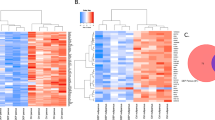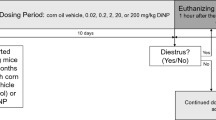Abstract
It has been suggested that environmental contaminants that mimic the effects of estrogen contribute to disruption of the reproductive systems of animals in the wild, and to the high incidence of hormone-related cancers and diseases in Western populations. Previous studies have shown that functionally, cadmium acts like steroidal estrogens in breast cancer cells as a result of its ability to form a high-affinity complex with the hormone binding domain of the estrogen receptor1,2. The results of the present study show that cadmium also has potent estrogen-like activity in vivo. Exposure to cadmium increased uterine wet weight, promoted growth and development of the mammary glands and induced hormone-regulated genes in ovariectomized animals. In the uterus, the increase in wet weight was accompanied by proliferation of the endometrium and induction of progesterone receptor (PgR) and complement component C3. In the mammary gland, cadmium promoted an increase in the formation of side branches and alveolar buds and the induction of casein, whey acidic protein, PgR and C3. In utero exposure to the metal also mimicked the effects of estrogens. Female offspring experienced an earlier onset of puberty and an increase in the epithelial area and the number of terminal end buds in the mammary gland.
This is a preview of subscription content, access via your institution
Access options
Subscribe to this journal
Receive 12 print issues and online access
$209.00 per year
only $17.42 per issue
Buy this article
- Purchase on Springer Link
- Instant access to full article PDF
Prices may be subject to local taxes which are calculated during checkout



Similar content being viewed by others
References
Garcia-Morales, P. et al. Effect of cadmium on estrogen receptor levels and estrogen-induced responses in human breast cancer cells. J. Biol. Chem. 269, 16896–16901 (1994).
Stoica, A., Katzenellenbogen, B.S. & Martin, M.B. Activation of estrogen receptor-alpha by the heavy metal cadmium. Mol. Endocrinol. 14, 545–553 (2000).
Russo, I.H. & Russo, J. Mammary gland neoplasia in long-term rodent studies. Environ. Health Perspect. 104, 938–967 (1996).
Vonderhaar, B.K. Regulation of development of the normal mammary gland by hormones and growth factors. in Breast Cancer: Cellular and Molecular Biology (eds. Lippman, M.E. & Dickson, R.B.) 251–294 (Kluwer, Boston, 1988).
Heineman, W.R., Mark, H.B., Wise, J.A. & Roston, D.A. in Laboratory Techniques in Electroanalytical Chemistry (eds. Kissinger, P.T. & Heineman, W.R.) (Marcel Dekker, New York, 1984).
Hilakivi-Clarke, L. et al. A maternal diet high in n-6 polyunsaturated fats alters mammary gland development, puberty onset, and breast cancer risk among female offspring. Proc. Natl. Acad. Sci. USA 94, 9372–9377 (1997).
Rothschild, T.C., Calhoon, R.E. & Boylan, E.S. Effects of diethylstilbesterol exposure in utero on the genital tracts of female ACI rats. Exp. Mol. Pathol. 48, 59–76 (1988).
Tamooka, T. & Bern, H.A. Growth of mouse mammary glands after neonatal sex hormone treatment. J. Natl. Cancer Inst. 69, 1347–1352 (1982).
Hilakivi-Clarke, L., Cho, E., Raygada, M. & Kenney, N. Alterations in mammary gland development following neonatal exposure to estradiol, transforming growth factor alpha, and estrogen receptor antagonist ICI 182,780. J. Cell Physiol. 170, 279–289 (1997).
Sharpe, R.M., Fisher, J.S., Millar, M.M., Jobling, S. & Sumpter, J.P. Gestational and lactational exposure of rats to xenoestrogens results in reduced testicular size and sperm production. Environ. Health Persp. 103, 1136–1143 (1995).
Beryllium, cadmium, mercury, and exposures in the glass manufacturing industry. 119–238 (International Agency for Research on Cancer, Lyon, 1993).
Waalkes, M.P. Cadmium carcinogenesis in review. J. Inorg. Biochem. 79, 241–244 (2000).
WHO Technical Report Series 901. Fifty-fifth report of the joint FAO/WHO expert committee on food additives, Geneva, 6-15 June 2000. Evaluation of certain food additives and contaminants (World Health Organization, Geneva, 2001).
Gartell, M.J., Craun, J.C., Podrebarae, D.S. & Gunderson, E.R. Pesticides, selected elements and other chemicals in adult total diet samples. October 1980–March 1982. J. Assoc. Anal. Chem. 69, 146–161 (1986).
Gartell, M.J., Craun, J.C., Podrebarae, D.S. & Gunderson, E.R. Pesticides, selected elements and other chemicals in infant and toddler total diet samples. October 1980–March 1982. J. Assoc. Anal. Chem. 69, 123–145 (1986).
Moschandreas, D.J. et al. Exposure apportionment: ranking food items by their contribution to dietary exposure. J. Expo. Anal. Environ. Epidemiol. 12, 233–243 (2002).
Wilhelm, M., Wittsiepe, J., Schrey, P., Budde, U. & Idel, H. Dietary intake of cadmium by children and adults from Germany using duplicate portion sampling. Sci. Total Environ. 285, 11–19 (2002).
Muller, M., Anke, M., Illing-Gunther, H. & Thiel, C. Oral cadmium exposure of adults in Germany. 2: Market basket calculations. Food Addit. Contam. 15, 135–141 (1998).
Ysart, G. et al. 1997 UK Total Diet Study—dietary exposures to aluminium, arsenic, cadmium, chromium, copper, lead, mercury, nickel, selenium, tin and zinc. Food Addit. Contam. 17, 775–786 (2000).
Jarup, L., Berglund, M., Elinder, C.G., Nordberg, G. & Vahter, M. Health effects of cadmium exposure—a review of the literature and a risk estimate. Scand. J. Work Environ. Health 24 (suppl. 1), 1–51 (1998).
Health assessment document of cadmium (EPA-600/8-81, NTIS Pub. PB82-115163). US Environmental Protection Agency, Office of Research and Development (1981).
International Agency for Research on Cancer. IARC monographs on the evaluation of carcinogenic risk of chemicals to man (cadmium, nickel, some expoxides, miscellaneous industrial chemicals and general considerations on volatile anaesthetics). 48–64 (World Health Organization, Geneva, 1976).
Antila, E., Mussalo-Rauhamaa, H., Kantola, M., Atroshi, F. & Westermarck, T. Association of cadmium with human breast cancer. Sci. Total Environ. (Netherlands) 186, 251–256 (1996).
Cantor, K.P., Stweart, P.A., Brinton, L.A. & Dosemeci, M. Occupational exposures and female breast cancer mortality in the United States. J. Occup. Med. (1994).
Martin, M.B. et al. Estrogen like activity of metals in MCF-7 breast cancer cells. Endocrinology 144, 2425–2436 (2003).
Acknowledgements
We thank M.E. Lippman for helpful discussions, R. Newbold for helpful discussions and critical reading of the manuscript, and A. Murray, I. Onojafe, G. Montenegro, A. Foxworth, D. Raval and W. Jefferson for technical assistance. This work was supported by National Institutes of Health grant CA70708, Cancer Research Foundation of America, The Susan G. Komen Foundation and an anonymous donation. Support for tissue culture, animal care and histopathology core facilities was provided by P50-CA58185 and P30-CA51008.
Author information
Authors and Affiliations
Corresponding author
Ethics declarations
Competing interests
The authors declare no competing financial interests.
Rights and permissions
About this article
Cite this article
Johnson, M., Kenney, N., Stoica, A. et al. Cadmium mimics the in vivo effects of estrogen in the uterus and mammary gland. Nat Med 9, 1081–1084 (2003). https://doi.org/10.1038/nm902
Received:
Accepted:
Published:
Issue Date:
DOI: https://doi.org/10.1038/nm902
This article is cited by
-
Exposure to environmental chemicals and cancer risk: epidemiological evidence from Japanese studies
Genes and Environment (2023)
-
Associations between exposure to cadmium, lead, mercury and mixtures and women’s infertility and long-term amenorrhea
Archives of Public Health (2023)
-
Associations between parental and postnatal metal mixture exposure and developmental delays in a Taiwanese longitudinal birth cohort of preschool children
Environmental Science and Pollution Research (2023)
-
Attenuating effects of selenium and zinc against hexavalent chromium-induced oxidative stress, hormonal instability, and placenta damage in preimplanted rats
Environmental Science and Pollution Research (2023)
-
Probabilistic Estimation of the Aggregate Dietary and Inhalation Exposure of Austrian Adults to Cadmium and Health Risk Assessment
Exposure and Health (2022)



